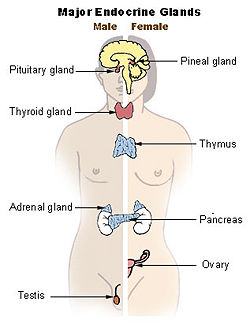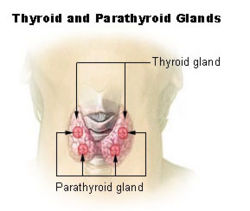Parathyroid gland
| Parathyroid gland | |
|---|---|
 |
|
| Endocrine system. (Parathyroid gland not pictured, but are present on surface of thyroid gland, as shown below.) | |
 |
|
| Thyroid and parathyroid. | |
| Latin | glandula parathyroidea inferior, glandula parathyroidea superior |
| Gray's | subject #273 1271 |
| Artery | superior thyroid artery, inferior thyroid artery, |
| Vein | superior thyroid vein, middle thyroid vein, inferior thyroid vein, |
| Nerve | middle cervical ganglion, inferior cervical ganglion |
| Precursor | neural crest mesenchyme and third and fourth pharyngeal pouch endoderm |
The parathyroid glands are small endocrine glands in the neck that produce parathyroid hormone. These glands are usually located behind the thyroid gland and in rare cases are located within the thyroid glands. Most people have four parathyroid glands, but some people have six or even eight.
Contents |
Anatomy
The parathyroid glands are four or more small glands located on the posterior surface of the thyroid gland. Histologically they are quite easily recognizable from the thyroid as they have densely packed cells in contrast with the follicle structure of the thyroid. [1] However at surgery they are harder to differentiate from the thyroid or fat.
They distinguish themselves from the thyroid gland histologically as they contain two types of cells:[2]
| Name | Staining | Quantity | Size | Function |
| parathyroid chief cells | darker | many | smaller | manufacture PTH (see below). |
| oxyphil cells | lighter | few | larger | function unknown.[3] |
History
The parathyroid glands were discovered by Ivar Viktor Sandström (1852-1889), a Swedish medical student, in 1880. [4] It was the last major organ to be recognized in humans.
Physiology
The sole function of the parathyroid glands is to maintain the body's calcium level within a very narrow range, so that the nervous and muscular systems can function properly.
When blood calcium levels drop below a certain point, calcium-sensing receptors in the parathyroid gland are activated to release hormone into the blood.
Parathyroid hormone (PTH, also known as parathormone) is a small protein that takes part in the control of calcium and phosphate homeostasis, as well as bone physiology. Parathyroid hormone has effects antagonistic to those of calcitonin. It increases blood calcium levels by stimulating osteoclasts to break down bone and release calcium. It also increases gastrointestinal calcium absorption by activating vitamin D, and promotes calcium uptake by the kidneys.
Role in disease
The single major disease of parathyroid glands is overactivity of one or more of the parathyroid lobes, which make too much parathyroid hormone causing a potentially serious calcium imbalance. This is called hyperparathyroidism; it leads to hypercalcemia and osteitis fibrosa cystica. Since hyperparathyroidism was first described in 1925, the symptoms have become known as "moans, groans, stones, and bones." The primary treatment for this disease is the surgical removal of the faulty gland.
Modern high frequency ultrasound can see parathyroid masses, even before they cause high calcium. They are called parathyroid incidentalomas. If a patient has elevated calcium, the ultrasound can be used to locate the abnormal glands. The use of ultrasound guided FNA, and parathyroid hormone washings can confirm the abnormal glands. A blood calcium 15-30 minutes after the biopsy can help determine if the disease is caused by a single abnormal gland or multiple glands.
A drop in serum calcium suggests a single source, and no drop suggests multiple glands. This, with a non-localizing Sestamibi scan would point toward a neck exploration, rather than a minimally invasive method aimed a single gland disease.
A Sestamibi scan is often used to determine which parathyroid gland(s) are responsible for overproduction of parathyroid hormone.
Another related condition is called secondary hyperparathyroidism, or secondary HPT - common in patients with chronic kidney disease on dialysis. In secondary HPT, the parathyroid glands make too much parathyroid hormone (PTH), and the kidneys do not produce enough vitamin D, and calcium and phosphorus are out of balance. Even though one may not have any symptoms, treating secondary HPT is important. Cinacalcet (Sensipar) is a medicine that can help treat such dialysis patients and is available by prescription only.
- Hypoparathyroidism
- Pseudohypoparathyroidism
- Pseudopseudohypoparathyroidism
- Disorders of the parathyroid hormone receptor have been associated with Jansen's metaphyseal chondroplasia and Blomstrand's chondroplasia.
Embryology and evolution
The parathyroid glands originate from the interaction of neural crest mesenchyme and third and fourth branchial pouch endoderm.
Genetically, Eya-1 (transcripitonal co-activator), Six-1 (a homeobox transcription factor), and Gcm-2 (a transcription factor) have been associated with the development of the parathyroid gland, and alterations in these genes alters parathyroid gland development.
The conserved homology of genes and calcium sensing receptors in fish gills with those in the parathryroid glands of birds and mammals is recognized by evolutionary developmental biology as evolution using genes and gene networks in novel ways to generate new structures with some similar functions and novel functions.
Additional images
References
- ↑ Histology at BU 15001ooa
- ↑ Histology at BU 15002loa
- ↑ Histology at OU 40_06
- ↑ Eknoyan G.. (1995). "A history of the parathyroid glands". Am J Kidney Dis 26 (5): 801–7. doi:. PMID 7485136.
External links
- Endocrine Web at endocrineweb.com
- The origin of the parathyroid gland at pnas.org
- Human Gland Probably Evolved From Gills at pandasthumb.org
- The role of the endoderm in the development and evolution of the pharyngeal arches at blackwell-synergy.com
- Parathyroid disease and treatments discussed in layman's terms at Parathyroid.com
- Deep homologies in the pharyngeal arches at scienceblogs.com
- Parathyroid+gland at eMedicine Dictionary
- Virtual Slidebox at Univ. Iowa Slide 149
|
|||||||||||||||||||